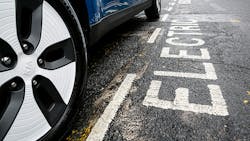For the past few years, there have been articles, reports, and studies on the electric vehicle industry. The conclusions have ranged from the inevitable growth of the industry to its inevitable downfall. In mid-June, $19 billion automotive supplier Marelli filed for bankruptcy, but following its trail reveals it’s only the latest domino to fall.
How Did We Get Here?
In 2023, the first alarm bell sounded as the rate of EV sales growth slowed. In the light-duty sales market, EV sales increased by 109% in 2021, but fell to 39% in 2023, and only 5% in 2024. It’s a small but significant distinction: Cars were still being sold, but the number wasn’t increasing as greatly as the previous year.
Also in 2023 came the first wave of EV-related bankruptcies. For the most part, these were start-ups like Lordstown Motors and Proterra Inc. Previous years, by contrast, has been filled with billion-dollar SPAC IPOs from the likes of Rivian and Lucid.
For some of these companies, bankruptcy was inevitable: Overly lofty goals that didn’t mesh with the reality of car making. The trend has continued even into 2025, with truck makers Hyzon and Nikola running out of capital earlier this year.
It seems like just yesterday the major automakers like Ford and GM were teaming up with EV start-ups and announcing plans to shift to all-electric by the 2030s and 40s. More recently, though, the trend has started to reverse, partially due to tariffs fears on top of industry slowdown. Major names like Honda have paused or backed off on EV-related goals, particularly in the short-term.
Ripple Effects
All of these dominoes bring us to now, with Marelli Corp entering Chapter 11.
In its June 11 filing, the Nissan supplier directly attributed part of its decline to a shift in attitudes about the EV industry.
Initially, Marelli landed multiple contracts to aid car companies in the shift to electric, but as demand decreased throughout 2023 and into 2024, triggering what the company called a “rapid volume reduction” in May 2024 as the manufacturers who once needed all the EV components they could get suddenly found themselves with a surplus and no need for Marelli.
As for what’s next for the supplier: leaders don’t anticipate much operational change. Marelli has secured a $1.1 billion financing commitment from its lenders, most of which agreed with its restructuring plan. In 2024, the company generated over $10 billion in revenue and has nearly $5 billion in debt. All of its secured debt will be eliminated, and, once it emerges from Chapter 11, ownership will change hands to the lenders of the new financing.
What’s next for the industry as a whole is a little more challenging. Marelli is more of a “ripple” effect, but it’s not the only one. COO Joseph Fadool at fellow automotive supplier BorgWarner Inc said the company had made the “difficult” decision to exit the charging business as well as consolidate its battery manufacturing operations.
Fadool largely attributed the charging exit to weak growth and a “highly competitive and disaggregated” market that led to doubt about its ability to “create shareholder value” in the short or midterm. Executives plan to shut down or sell its five locations in business during the second quarter.
“While the decision to exit charging was not easy, we believe that it will further strengthen our product portfolio and position BorgWarner to continue to grow profitably,” he said.
EVs are Far From Done
On the larger scale for electric vehicles, it’s important to remember that while things don’t look great, it’s still an early market, according to Seth Goldstein, an analyst at Morningstar Research.
“EV sales are still very heavily influenced by government actions, including subsidies, including funds for EV charging build-out and including automaker regulations,” he said.
While he characterized Biden administration as having “favorable policies,” he pointed to the lack of fast charger availability throughout the country. The inadequate infrastructure means customers continue to hesitate before pulling the trigger on a purchase.
EVs also aren’t quite in the realm of “affordable” yet, which is where most consumer are looking to buy. They perform well in the luxury market, where they are 20% of sedans sold, and 30% – 40% of SUV sales.
Fixing both the price and infrastructure will take time. Prices will come down as automakers shift to mass production of EVs and create more affordable models, alongside falling battery prices, one of the most expensive parts to source. This year, Chevrolet is debuting the Equinox EV, offering more than 300 miles of range with a price tag comparable to a Toyota RAV4 and Tesla’s Model Y refresh starts in the mid-$40,000s.
“The infrastructure is sort of a big wild card. I think we will get the chargers built, but it's likely going to take until 2028 or so until we really see consumers feel confident they can take a road trip in an EV,” Goldstein said.
As for government subsidies, Goldstein says it could go either way in the short-term, but that the market will eventually bounce back regardless, using Germany as an example. The country cut its federal subsidy for electric vehicles at the end of 2023, leading to decline in sales for 2024, but the market has already rebounded just six months into 2025.
“If we see the subsidy in the U.S. be cut, we'd see something similar, where we see a 2026 decline, but then EVs growing again in 2027 as more, new lower-cost models come out. So longer term, I think it's still very bright for EVs,” Goldstein said.
